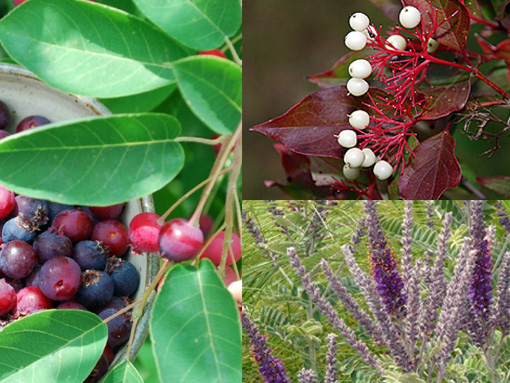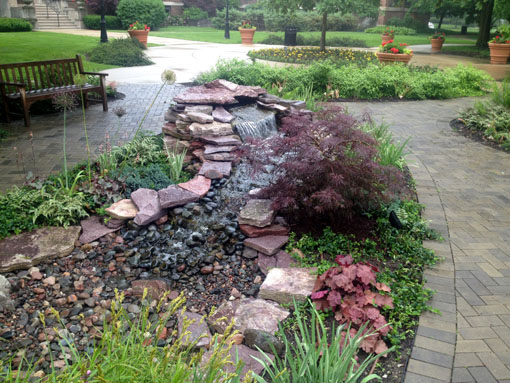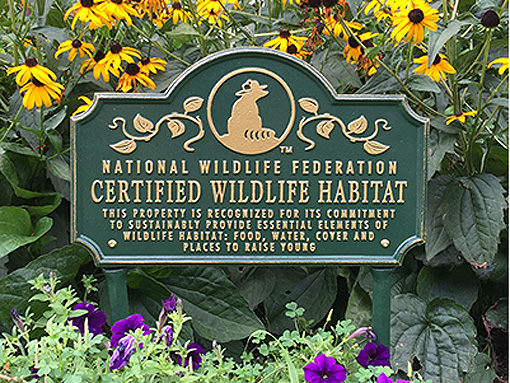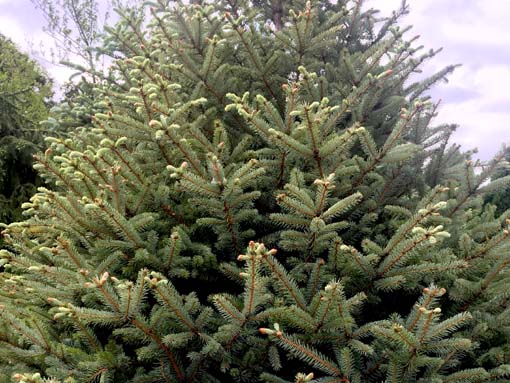We all love feeling a connection to nature and wildlife when we visit nearby parks and forest preserves. Have you ever thought about bringing that feeling home? There are many things you can do in your own yard to create a garden that attracts wildlife, regardless of how much space you have. You don’t need to have a large pond or prairie to bring birds and animals to your neck of the woods. By incorporating key elements, your garden can become an official Certified Wildlife Habitat through the National Wildlife Federation (NWF). There are only four main requirements for a garden to become certified, some of which you may already have: that it provides a food source, a water source, a place for wildlife to live and areas for them to raise their young.

These native plants are not only attractive but provide food for birds. Clockwise from top right: Gray Dogwood; Lead Plant; Serviceberry.
Food
Many types of birdfeeders and blends of birdseed and suet are available on the market. Additionally, there are native species of plants in our area that would not only beautify your garden but also provide food for wildlife, bearing fruit or seeds. A few examples of these are Serviceberry, a small ornamental tree with crisp white flowers in spring that turn to edible reddish-purple berries; Gray Dogwood, an 8-10 ft. tall shrub whose fruit provides food for songbirds; and Lead Plant, a 3 ft. tall perennial whose seeds are eaten by birds.

A pondless waterfall offers the soothing sound of falling water and the beauty of a traditional pond, but requires far less maintenance.
Water
Water sources can be as simple as a bubbling rock or birdbath; however, if you have the room in your yard for a water garden or stream, feathered friends will surely flock to your garden.
Shelter
Birdhouses are the obvious examples for housing certain species that are cavity dwellers in nature. Consult a birdhouse chart from a birding website to select the right one for your garden; the National Wildlife Federation website has a general guide. Trees, shrubs and evergreens also make great places for birds to nest.

Swamp Milkweed, a 3-4 ft. tall perennial with pretty pink flowers, is the preferred host plant of the endangered and beautiful Monarch Butterfly.
A Place to Raise Young
Birdhouses, mature trees and shrubs, host plants for caterpillars, dense vegetation, combined with food and water sources provide the ideal environment for wildlife to raise their young.
Applying for CWH Certification

The NWF offers a distinctive, recycled cast aluminum garden sign along with its standard 9″x12″ aluminum sheet sign.
Once you have fulfilled these requirements, you can apply online to become an official Certified Wildlife Habitat. The NWF has a great website full of information on making your garden the perfect place for wildlife and other important tips and tricks.
Evanston has its own program which encourages residents to obtain the NWF certification. This initiative, Natural Habitat Evanston, seeks to engage the whole community through such activities as workshops about birds, pollinators and the plants of greatest benefit to them, invasive plant removal and other volunteer training events. Visit the website.
There are over 60 Evanston homes which currently have the NWF certification. If you live in Evanston, why not add your yard to the list? If you are missing a few of the necessary requirements to become certified, or would like assistance in doing so, let us help. We’d be happy to work with you to create an oasis for you and your winged friends (birds, bees and butterflies).
A Few Considerations
Wildlife gardens tend to have an unkempt and natural/prairie-like appearance, which isn’t for everyone. Also, this garden installation may attract bees (among other wildlife) to your property, so keep this in mind if you or any family member is allergic. If you decide to install a wildlife garden at your home, you’ll get the best results if installed in early spring or in late summer/early fall. As with any landscape installation, regular maintenance is required to ensure a successful wildlife habitat. We offer full maintenance programs to help keep your habitat looking great. Just remember, no matter how big or small your yard may be, there are ways to bring nature home.

